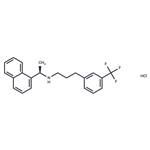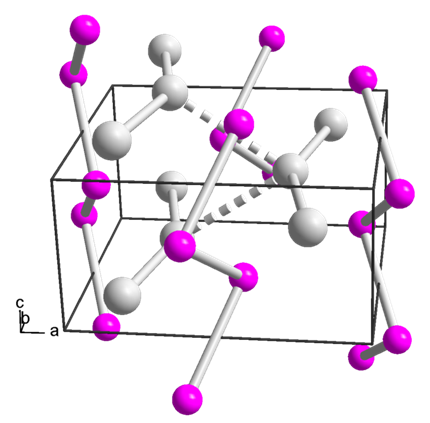Cinacalcet hydrochloride: A novel calcimimetic
Apr 1,2024
Introduction
Cinacalcet is a medication used in the management and treatment of secondary hyperparathyroidism (on dialysis population), primary hyperparathyroidism for which the patient may not be a surgical candidate and the treatment of calciphylaxis in patients with advanced kidney disease or on dialysis. It belongs to the calcimimetic class of medications.

Oral cinacalcet hydrochloride (HCl) is the first in a new class of therapeutic agents, calcimimetics, and has a novel mechanism of action. Cinacalcet hydrochloride classifies as a "calcimimetic." It directly modulates the principal regulator of parathyroid hormone (PTH) secretion, namely the calcium-sensing receptor (CaR) on the chief cells in the parathyroid gland. Calcimimetics are orally active molecules that decrease the secretion of parathyroid hormone by activating calcium receptors. This class of compounds is used to treat hyperparathyroidism, a condition characterized by the oversecretion of parathyroid hormone[1]. Cinacalcet HCl reduces circulating PTH levels by increasing the sensitivity of the CaR to extracellular calcium.
Mechanism of action
The current treatment goals are to reduce calcium in primary hyperparathyroidism and to lower PTH, calcium, and phosphorus levels in secondary hyperparathyroidism. The main factor involved in regulating PTH secretion is the concentration of extracellular calcium. The CaR, a cell surface receptor expressed on parathyroid chief cells and other tissues, has an important role in recognizing changes in the concentration of calcium in the blood and mediating the effect of calcium on the secretion of PTH from the parathyroid glands. Thus, an increase in serum calcium results in rapid decreases in PTH secretion via activation of the CaR in the parathyroid. Conversely, a decrease in extracellular calcium levels results in inactivation of the CaR and promotes PTH release. Cinacalcet binds to the CaR and increases the CaR's sensitivity to activation by extracellular calcium, thereby modifying PTH release and helping restore the calcium and phosphorus balance. Using different cell lines with CaR of human, bovine, or rat origin, cinacalcet increased cytoplasmic calcium, inhibited PTH release in parathyroid cells, and increased calcitonin release from thyroid cells. Clinical trials have demonstrated normalization of serum calcium and reductions in PTH in patients with primary hyperparathyroidism and reductions in PTH, calcium, and phosphorous in patients with secondary hyperparathyroidism[2].
Indication
The primary indication of cinacalcet hydrochloride is to reduce the parathyroid hormone level in patients with secondary hyperparathyroidism associated with end-stage kidney disease. In chronic kidney disease, patients often have high phosphorus levels, variable calcium levels, and increased parathyroid hormone levels (>300 pg/mL). The role of the cinacalcet in this condition is to reduce the serum parathyroid hormone level and prevent bone destruction. This intervention reinstates the calcium levels within the target ranges defined by the Kidney Disease Outcomes Quality Initiative (K-DOQI) for disease management[3]. It reduces the chances of requiring a parathyroidectomy for secondary hyperparathyroidism. Clinicians often use this medication in combination therapy with an oral phosphorous binder (calcium acetate, sevelamer) and vitamin D analogs (calcitriol, paricalcitol).
References
[1] Julia A Barman Balfour, Lesley J Scott. “Cinacalcet hydrochloride.” Drugs 65 2 (2005): 271–81.
[2] Desmond Padhi, Robert Harris. “Clinical pharmacokinetic and pharmacodynamic profile of cinacalcet hydrochloride.” Clinical Pharmacokinetics 48 5 (2009): 303–11.
[3] Yokoyama, Keitaro. “Clinical issues regarding cinacalcet hydrochloride in Japan.” Therapeutic Apheresis and Dialysis 13 Suppl 1 (2009): S12-4.
- Related articles
- Related Qustion
- Cinacalcet hydrochloride: Uses, Synthesis and Dosage Jul 30, 2025
Cinacalcet hydrochloride is the first active pharmaceutical ingredient approved by the US FDA for the treatment of secondary hyperparathyroidism.
Supplementation with pyridoxal 5'-phosphate monohydrate can synthesize neurotransmitters such as dopamine and serotonin, maintaining a healthy nervous system.....
Nov 4,2025Biochemical EngineeringPlatinum silicide is an inorganic compound with the formula PtSi. It is a semiconductor that turns into a superconductor when cooled to 0.8 K.....
Apr 1,2024Inorganic chemistryCinacalcet hydrochloride
364782-34-3You may like
Cinacalcet hydrochloride manufacturers
- Cinacalcet hydrochloride
-

- $0.00 / 1Kg/Bag
- 2025-12-18
- CAS:364782-34-3
- Min. Order: 1KG
- Purity: 99%min
- Supply Ability: 500kgs
- Cinacalcet hydrochloride
-

- 2025-12-17
- CAS:364782-34-3
- Min. Order:
- Purity: 0.99
- Supply Ability:
- Cinacalcet hydrochloride
-

- $43.00 / 10mg
- 2025-12-16
- CAS:364782-34-3
- Min. Order:
- Purity: 99.96%
- Supply Ability: 10g






